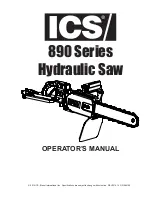
-27-
from jamming and the safeguard of the bottom wire
deflection prevents the machine from turning up.
Particulary convenient and low-dust working is
possible with the cutting table ST 1700 Vario, the
high-volume vacuum cleaner S 200 M and the
machine holder MH-DSS, all available as optional
accessories.
Nails or adhering sand will damage
the saw wire. They must be
removed from the cut surface.
5.5 Sawing according to tracings
The gear case is equipped with a tracing edge for 0°
to 60°. This tracing edge corresponds to the saw
wire's inside. For bevel cuts, the tracing can be
viewed through the opening on the left-hand side of
the rear saw guard.
Hold the machine by its handles and place the
front part of its base plate onto the workpiece.
Switch on the wire saw for insulation material
(see Chapter 5.2 Switching on and off, page 26)
and slide the machine evenly forward in cutting
direction.
When the cut is completed, switch off the saw
by releasing the switch trigger 29 (Fig. 1).
5.6 Sawing on the guide rail
The use of a guide rail achieves a
clearly higher cut quality.
Fasten the guide rail in the desired position on
the workpiece (for this the clamping device F-
FIX is very useful - see chapter 8 Optional
accessories, page 29).
Install the supplementary support plate and the
glider where required (see chapter 4.9
Supplementary support plate and glider, page
26).
Hold the machine by its handles and place the
front part of its base plate into the guide rail.
Switch on the wire saw for insulation material
(see Chapter 5.2 Switching on and off, page 26)
and slide the machine evenly forward in cutting
direction.
When the cut is completed, switch off the saw
by releasing the switch trigger 29 (Fig. 1).
The double-toothed belt should be
fitted when working with insulation
material of a density > 160 kg/m³
(see chapter 4.3 Installation of
double-toothed belt, page 23).
The riving knife/splitter should be
shifted to the rear by 15° when
working with insulation material of a
density > 160 kg/m³ (see chapter
4.7 Setting for bevel cuts, page 25).
5.7 Free form cutting
The double-toothed bolt must be
dismantled during free form cutting
(see 4.3 Installation of double-
toothed belt, page 23)
The round shape of the blades makes it possible to
cut the workpiece in any direction. This makes it very
easy to produce cutouts for rafters or openings.
Hold the machine by its handles and place the
front part of its base plate onto the workpiece.
Switch on the wire saw for insulation material
(see Chapter 5.2 Switching on and off, page 26)
and slide the machine evenly forward in cutting
direction.
when the cut is completed, switch off the saw by
releasing the switch trigger 29 (Fig. 1).
Free form cuts can also be carried
out with the wire set tilted to the
rear.
Caution: Sawing with the wire set
tilted to the rear requires you to
work with increased attentiveness!

































